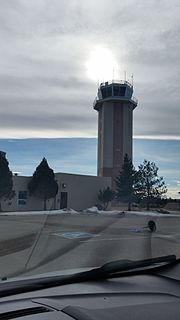
Western Airlines was a major airline based in California, operating in the western United States including Alaska and Hawaii, and western Canada, as well as to New York City, Boston, Washington, D.C., and Miami and to Mexico, London and Nassau. Western had hubs at Los Angeles International Airport, Salt Lake City International Airport, and the former Stapleton International Airport in Denver. Before it merged with Delta Air Lines in 1987 it was headquartered at Los Angeles International Airport (LAX). Throughout the company's history, their slogan was "Western Airlines...The Only Way to Fly!"

Hughes Airwest was an airline in the western United States, backed by Howard Hughes' Summa Corporation. The airline's original name was Air West. Hughes Airwest flew routes in the western U.S. and to several destinations in Mexico and Canada; its headquarters were on the grounds of San Francisco International Airport (SFO) in unincorporated San Mateo County, California.

The Boeing Model 247 is an early United States airliner, considered the first such aircraft to fully incorporate advances such as all-metal semimonocoque construction, a fully cantilevered wing, and retractable landing gear. Other advanced features included control surface trim tabs, an autopilot and de-icing boots for the wings and tailplane.

Edwin Charles Musick was chief pilot for Pan American World Airways and pioneered many of Pan Am's transoceanic routes including the famous route across the Pacific Ocean on the China Clipper.

The Dole Air Race, also known as the Dole Derby, was a deadly air race across the Pacific Ocean from Oakland, California to Honolulu in the Territory of Hawaii held in August 1927. There were eighteen official and unofficial entrants; fifteen of those drew for starting positions, and of those fifteen, two were disqualified, two withdrew, and three aircraft crashed before the race, resulting in three deaths. Eight aircraft eventually participated in the start of the race on August 16, with only two successfully arriving in Hawaii; Woolaroc, a Travel Air 5000 piloted by Arthur C. Goebel and William V. Davis, arrived after a 26 hour, 15 minute flight, leading runner-up Aloha by two hours.

Cheyenne Regional Airport is a civil-military airport a mile north of downtown Cheyenne, in Laramie County, Wyoming. It is owned by the Cheyenne Regional Airport Board.

United Airlines Flight 409 was a scheduled flight which originated in New York City, New York. The final flight destination was San Francisco, California, with stops in Chicago, Denver and Salt Lake City. The aircraft operating the service, a Douglas DC-4 propliner, registration N30062, crashed into Medicine Bow Peak, near Laramie, Wyoming, on October 6, 1955, killing all 66 people on board. The victims included five female members of the Mormon Tabernacle Choir and military personnel. At the time, this was the deadliest airline crash in the history of American commercial aviation. Another 66 lives had been lost earlier that year in the March 22 crash in Hawaii of a United States Navy Douglas R6D-1 Liftmaster military transport aircraft, and 66 had also died in the mid-air collision of two United States Air Force C-119G Flying Boxcars over West Germany on August 11, placing the three crashes in a three-way tie as the deadliest aviation incidents in 1955.
Leon Dewey "Lee" Cuddeback flew the first scheduled, civilian Air Mail flight in the United States on April 6, 1926. He did so as chief pilot of Varney Air Lines. His route began in Pasco, Washington, had a stop in Boise, Idaho, and terminated in Elko, Nevada. Because the start of the contract air mail system is considered the beginning of airline service, Cuddeback's flight is cited as the first U.S. airline flight, and is also celebrated as the "birthday" of United Airlines.

The crash of TWA Flight 8 involved a Transcontinental & Western Air Douglas DC-2. On March 1, 1938, during a scheduled passenger flight from San Francisco to Winslow, Arizona, TWA's interstate hub, the flight encountered severe weather. The pilot radioed his intention to land in nearby Fresno. The aircraft subsequently crashed on a mountain in Yosemite National Park, and was found three months later.

United Airlines Trip 4 was a Boeing 247D operating on a scheduled flight from Salt Lake City, Utah, to Cheyenne, Wyoming, on October 7, 1935. The aircraft last contacted Cheyenne at 02:16 or 02:17, reporting its position as Silver Crown. Cheyenne called the flight at 02:21, receiving no reply. The weather was virtually clear with ceiling unlimited.

Chicago and Southern Air Lines Flight 4 was a regularly scheduled flight from New Orleans, Louisiana to Chicago, Illinois via Jackson, Mississippi; Memphis, Tennessee; and St. Louis, Missouri operated with a Lockheed Model 10 Electra. On August 5, 1936, after departing from Lambert-St. Louis International Airport, the flight crashed in a farm field near the Missouri River. All 6 passengers and 2 crew members were killed in the crash.
In 1934, all United States commercial air mail carrying contracts were cancelled due to controversy over how the contracts had been awarded. The United States Army Air Corps was charged with carrying air mail service, beginning 19 February 1934. Due in part to extremely bad weather, inadequate preparation of the mail pilots, and the inadequacies of pressing military aircraft into duties for which they were not designed, there ensued a series of accidents over the following three months, ending when commercial services were restored. In all, 66 major accidents, ten of them with fatalities, resulted in 13 crew deaths, creating an intense public furor. Only five of the 13 deaths actually occurred on flights carrying mail, but directly and indirectly the air mail operation caused accidental crash deaths in the Air Corps to rise by 15 percent to 54 in 1934, compared to 46 in 1933 and 47 in 1935.









